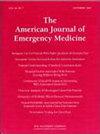Performance of the artificial intelligence-based Swiss medical assessment system versus Manchester triage system in the emergency department: A retrospective analysis
IF 2.7
3区 医学
Q1 EMERGENCY MEDICINE
引用次数: 0
Abstract
Background
The emergence of artificial intelligence (AI) offers new opportunities for applications in emergency medicine, including patient triage. This study evaluates the performance of the Swiss Medical Assessment System (SMASS), an AI-based decision-support tool for rapid patient assessment, in comparison with the well-established Manchester Triage System (MTS).
Methods
In this retrospective analysis, patients aged 18 years or above presenting to the Department of Emergency Medicine at Kepler University Hospital in Linz, Austria, during November and December 2024 with non-traumatic complaints were included. Each patient underwent emergency triage using MTS, conducted by a registered nurse, with SMASS applied in parallel. SMASS had no influence on clinical decision-making.
Results
In the study period, 1021 patients were triaged with both MTS and SMASS. The mean patient age was 60 years (SD: 21), and 53 % were women. Of the patients categorized as “orange” by MTS, 19 % were classified as non-urgent by SMASS. Conversely, 28 % of the patients triaged as “green” by MTS were classified as urgent by SMASS. Additionally, 23 % of patients classified as non-urgent by SMASS required hospitalization following emergency department evaluation and treatment. Agreement between SMASS and MTS in triaging emergency patients was low as measured by a Cohen's kappa of 0.167.
Conclusions
In this study of patients presenting to a large tertiary-care emergency department, SMASS demonstrated considerable discrepancies in triage classification compared to MTS, with significant rates of both over- and undertriage. Further validation is necessary before integrating AI-based triage tools into routine clinical practice.
基于人工智能的瑞士医疗评估系统与曼彻斯特分诊系统在急诊科的表现:回顾性分析
人工智能(AI)的出现为急诊医学的应用提供了新的机会,包括患者分诊。本研究评估了瑞士医疗评估系统(SMASS)的性能,这是一种基于人工智能的决策支持工具,用于快速患者评估,与完善的曼彻斯特分诊系统(MTS)进行比较。方法回顾性分析2024年11月至12月在奥地利林茨开普勒大学医院急诊科就诊的年龄在18岁及以上的非创伤性主诉患者。每位患者都使用MTS进行紧急分诊,由一名注册护士进行,同时应用SMASS。SMASS对临床决策没有影响。结果在研究期间,1021例患者同时接受了MTS和SMASS。患者平均年龄为60岁(SD: 21), 53%为女性。在MTS分类为“橙色”的患者中,19%的患者被SMASS分类为非紧急。相反,28%被MTS分类为“绿色”的患者被SMASS分类为紧急。此外,23%被SMASS分类为非紧急的患者在急诊科评估和治疗后需要住院。根据科恩kappa值0.167衡量,SMASS和MTS在分诊急诊患者方面的一致性较低。结论:在这项研究中,在大型三级护理急诊科就诊的患者中,与MTS相比,SMASS在分诊分类上存在相当大的差异,分诊过多和分诊不足的比例都很显著。在将基于人工智能的分诊工具整合到常规临床实践之前,需要进一步验证。
本文章由计算机程序翻译,如有差异,请以英文原文为准。
求助全文
约1分钟内获得全文
求助全文
来源期刊
CiteScore
6.00
自引率
5.60%
发文量
730
审稿时长
42 days
期刊介绍:
A distinctive blend of practicality and scholarliness makes the American Journal of Emergency Medicine a key source for information on emergency medical care. Covering all activities concerned with emergency medicine, it is the journal to turn to for information to help increase the ability to understand, recognize and treat emergency conditions. Issues contain clinical articles, case reports, review articles, editorials, international notes, book reviews and more.

 求助内容:
求助内容: 应助结果提醒方式:
应助结果提醒方式:


